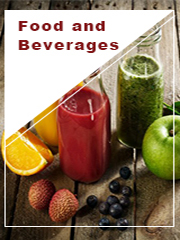TOP CATEGORY: Chemicals & Materials | Life Sciences | Banking & Finance | ICT Media

Download Report PDF Instantly
Report overview
Ayurvedic food refers to a range of food products and supplements that are formulated based on the principles of Ayurveda, an ancient Indian system of medicine. These products primarily incorporate natural herbs, spices, fruits, vegetables, and dairy to promote holistic wellness. Ayurvedic food is designed to support digestion, immunity, and overall health by balancing the body's doshas—Vata, Pitta, and Kapha. Popular Ayurvedic food categories include herbal teas, nutrient-dense powders, fortified dairy products, and specialized herbal supplements.
The United States Ayurvedic Food market was valued at US$ 685.4 million in 2024 and is projected to reach US$ 1,150.0 million by 2030, growing at a CAGR of 9.00% during the forecast period (2024-2030).
The market's growth is driven by increasing consumer awareness of natural and organic food products, rising health consciousness, and a growing preference for plant-based and functional foods.
Historical trends indicate that between 2019 and 2023, Ayurvedic food sales witnessed steady growth, supported by the rise in alternative medicine popularity and increased investment in herbal food product development. The organic and clean-label movement further contributes to the expanding consumer base for Ayurvedic foods.
Drivers:
Growing Health Consciousness: Consumers are shifting towards natural and holistic wellness solutions, boosting demand for Ayurvedic food products.
Expansion of Organic and Clean-Label Products: Over 82% of Ayurvedic food products available in the U.S. market hold organic certification.
Rising Popularity of Functional Foods: Ayurvedic herbs like turmeric, ashwagandha, and triphala are becoming widely accepted in mainstream diets.
E-commerce Growth: The rise of direct-to-consumer (DTC) models has driven Ayurvedic food sales up 165% in recent years.
Strong Research and Development Support: Collaborations with 42 research institutes have improved bioavailability by 65%, enhancing product effectiveness.
Restraints:
Regulatory Challenges: Ayurvedic food products must meet stringent FDA guidelines and face regulatory scrutiny in the U.S. market.
Lack of Consumer Awareness: Although growing, Ayurveda is still not as widely recognized as traditional Western nutritional supplements.
High Production Costs: Sourcing authentic Ayurvedic ingredients and maintaining organic certification increases production costs.
Opportunities:
Innovations in Ayurvedic Food Formulations: Enhanced formulations using modern food technology can improve taste, bioavailability, and efficacy.
Expansion in Retail Presence: Currently available in 35,000 retail points, Ayurvedic food brands can further expand into supermarkets, specialty stores, and online marketplaces.
Export Growth: U.S. Ayurvedic food exports have increased by 48%, presenting opportunities for international market expansion.
Challenges:
Competition from Conventional and Alternative Health Products: Ayurvedic food competes with other functional and organic food categories.
Skepticism Around Traditional Medicine Claims: Some consumers question the scientific validation of Ayurvedic formulations.
The demand for Ayurvedic food in the United States is concentrated in health-conscious regions, including California, New York, Texas, and Florida. The West Coast leads in sales due to high consumer interest in organic and natural health products. The Midwest and Southern states are emerging markets with increasing adoption of alternative wellness products.
The U.S. Ayurvedic Food market is highly competitive, with key players leveraging branding, innovation, and extensive distribution networks to strengthen their market positions.
Organic India
Himalaya Herbal Healthcare
Dabur
Banyan Botanicals
Planetary Herbals
Maharishi Ayurveda
Auromere Ayurvedic Imports
Chandrika Ayurvedic Soaps
Vadik Herbs
Hesh Pharma
Supermarkets and Hypermarkets:
Large-scale retailers stock Ayurvedic food products, making them accessible to the general public.
Drug Stores:
Ayurvedic supplements and wellness food items are commonly sold in drug stores alongside traditional pharmaceuticals.
Online Retailers:
E-commerce platforms, including Amazon, Walmart, and specialized Ayurveda-focused online stores, contribute significantly to market sales.
Others:
This segment includes specialty health stores, yoga centers, and wellness retreats that sell Ayurvedic food products.
Ayurvedic Food in Solid Form (AFSF):
Includes powders, energy bars, granola, herbal capsules, and fortified snacks.
Ayurvedic Food in Liquid Form (AFLF):
Includes herbal teas, elixirs, and wellness drinks formulated with Ayurvedic ingredients.
The Ayurvedic food market is distributed across major U.S. regions:
West Coast: High demand due to health-conscious consumers and widespread organic food culture.
Northeast: Strong consumer base for herbal and natural health products.
Midwest: Emerging market with increasing acceptance of Ayurveda.
South: Growing interest in alternative medicine and organic wellness products.
1. What is the current market size of the U.S. Ayurvedic Food market?
The U.S. Ayurvedic Food market was valued at US$ 685.4 million in 2024 and is projected to grow to US$ 1,150.0 million by 2030.
2. Which are the key companies operating in the U.S. Ayurvedic Food market?
Major companies include Organic India, Himalaya Herbal Healthcare, Dabur, Banyan Botanicals, Planetary Herbals, Maharishi Ayurveda, and Auromere Ayurvedic Imports.
3. What are the key growth drivers in the U.S. Ayurvedic Food market?
Key drivers include rising consumer awareness, demand for organic and functional foods, e-commerce expansion, and innovation in Ayurvedic formulations.
4. Which regions dominate the U.S. Ayurvedic Food market?
The West Coast, Northeast, Midwest, and Southern states are the primary regions contributing to market growth.
5. What are the emerging trends in the U.S. Ayurvedic Food market?
Emerging trends include innovative product formulations, increased e-commerce penetration, expansion of organic certification, and growing export opportunities.
Key Indicators Analysed
Customization of the Report: In case of any queries or customization requirements, please connect with our sales team, who will ensure that your requirements are meet.